The last quarter of 2016 went by so quickly that the year ended with books still on the to-be-read stack. This week, we review some of these books we’ve been reading in January that are just too good to miss.
Ages 4–8
All the World a Poem. Gilles Tibo. Trans. Erin Woods. Ill. Manon Gauthier. 2016. Pajama.
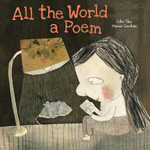 Poems about poems, written from children’s points of view, describe their feelings and experiences of reading and writing them. Some of Gilles Tibo’s poetry is decidedly child friendly (“I love poems sweet and silly. / I love poems long and frilly— / All the poems dreaming on the shelf.”) and some is sophisticated (“To write poetry / is to pluck silence like a flower / and press it gently between the pages / of a notebook / made of light.”). Manon Gauthier’s collage art featuring childlike drawings of girls and boys cut out and placed on mixed-media backgrounds will draw the attention of young children to this picture book that invites them to explore the world of poetry through both reading and writing.
Poems about poems, written from children’s points of view, describe their feelings and experiences of reading and writing them. Some of Gilles Tibo’s poetry is decidedly child friendly (“I love poems sweet and silly. / I love poems long and frilly— / All the poems dreaming on the shelf.”) and some is sophisticated (“To write poetry / is to pluck silence like a flower / and press it gently between the pages / of a notebook / made of light.”). Manon Gauthier’s collage art featuring childlike drawings of girls and boys cut out and placed on mixed-media backgrounds will draw the attention of young children to this picture book that invites them to explore the world of poetry through both reading and writing.
—CA
Lucky Lazlo. Steve Light. 2016. Candlewick.
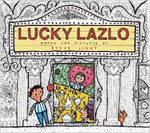 Lazlo is in love, and he is lucky to buy the flower seller’s last red rose, which he plans to present to his lady love, who is starring as Alice in the production of Alice in Wonderland at the Peacock Theater. On the way, Lazlo has some bad luck. He runs into a post and drops the rose. A cat snatches it up, and the chase is on through the stage door and past actors, musicians, and stagehands backstage. Both the cat and Lazlo have moments on stage. The cat disrupts the Mad Hatter’s tea party scene, and once Lazlo recovers the rose that the cat drops to pursue a mouse, he steps on a ball and steals the show by wobbling on it across the stage. All ends well with Lazlo presenting the rose to his Alice (and winning a kiss) and the cat having caught the mouse. In an author’s note, Light explains theatrical superstitions shown in his intricately detailed pen-and-ink illustration that have been broken by the cast and crew and challenges readers to find them.
Lazlo is in love, and he is lucky to buy the flower seller’s last red rose, which he plans to present to his lady love, who is starring as Alice in the production of Alice in Wonderland at the Peacock Theater. On the way, Lazlo has some bad luck. He runs into a post and drops the rose. A cat snatches it up, and the chase is on through the stage door and past actors, musicians, and stagehands backstage. Both the cat and Lazlo have moments on stage. The cat disrupts the Mad Hatter’s tea party scene, and once Lazlo recovers the rose that the cat drops to pursue a mouse, he steps on a ball and steals the show by wobbling on it across the stage. All ends well with Lazlo presenting the rose to his Alice (and winning a kiss) and the cat having caught the mouse. In an author’s note, Light explains theatrical superstitions shown in his intricately detailed pen-and-ink illustration that have been broken by the cast and crew and challenges readers to find them.
—CA
Story Worlds: Nature. Thomas Hegbrook. 2016. 360 Degrees/Tiger Tales.
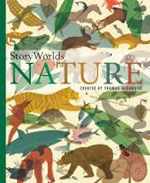 “Every picture tells a story. What do you think that story is?” on the title page leads readers into this oversize volume, in which Thomas Hegbrook creates scenes from the world of nature that are wordless stories. A note on the publication page suggests how to explore this book: Observe each scene, inquire by becoming the narrator for each visual story, and wonder about the amazing animals and their behavior the scenes reveal. The arrangement of the 100 scenes vary, with a few spreads, some full-page scenes, and pages with two to five rectangular panels in different layouts on a page. After telling their own stories, readers can refer to Hegbrook’s notes identifying the animals and explaining the scenes. Readers of all ages will enjoy exploring nature in this intriguing wordless picture book.
“Every picture tells a story. What do you think that story is?” on the title page leads readers into this oversize volume, in which Thomas Hegbrook creates scenes from the world of nature that are wordless stories. A note on the publication page suggests how to explore this book: Observe each scene, inquire by becoming the narrator for each visual story, and wonder about the amazing animals and their behavior the scenes reveal. The arrangement of the 100 scenes vary, with a few spreads, some full-page scenes, and pages with two to five rectangular panels in different layouts on a page. After telling their own stories, readers can refer to Hegbrook’s notes identifying the animals and explaining the scenes. Readers of all ages will enjoy exploring nature in this intriguing wordless picture book.
—CA
Teddy & Co. Cynthia Voigt. Ill. Paola Zakimi. 2016. Alfred A. Knopf/Random House.
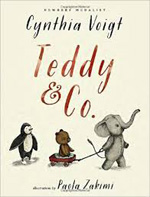 In a magical community, the lives of lost toys (a deep-thinking paraplegic teddy bear, two charming pigs, a hungry snake, an elephant who bakes, and a hermit penguin) revolve around baked muffins and gentle (a picnic at the beach) and not-so-gentle (a dangerous trek that reveals they live on a small island) adventures until a rabbit, who is not what he seems, washes up on shore followed by the arrival of a bossy, beautiful doll who declares herself queen—and demands a castle. These distinct characters with childlike personalities slowly meld into a community, with some of them evolving a little, and others a lot, in their individual journeys of self-discovery. All the toys learn that it is OK to be who they are as long as they respect one another’s differences. The short chapters, complemented by black-and-white illustrations, can serve as stand-alone stories perfect for reading aloud in one sitting.
In a magical community, the lives of lost toys (a deep-thinking paraplegic teddy bear, two charming pigs, a hungry snake, an elephant who bakes, and a hermit penguin) revolve around baked muffins and gentle (a picnic at the beach) and not-so-gentle (a dangerous trek that reveals they live on a small island) adventures until a rabbit, who is not what he seems, washes up on shore followed by the arrival of a bossy, beautiful doll who declares herself queen—and demands a castle. These distinct characters with childlike personalities slowly meld into a community, with some of them evolving a little, and others a lot, in their individual journeys of self-discovery. All the toys learn that it is OK to be who they are as long as they respect one another’s differences. The short chapters, complemented by black-and-white illustrations, can serve as stand-alone stories perfect for reading aloud in one sitting.
—NB
Ages 9–11
The Dog, Ray. Linda Coggin. 2016. Candlewick.
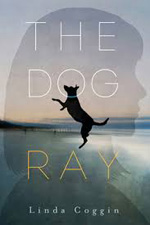 Twelve-year-old Daisy dies in a tragic car accident and finds herself in an afterworld job center. Although she is assigned to return to Earth as a dog, she still thinks like the human Daisy. Beginning her new life as Misty, she is adopted and mistreated by a boy named Cyril but escapes from her collar after being abandoned by him at a park. Driven to locate her paralyzed father who, she reads in a newspaper, survived the accident, she longs to be reunited with her parents. After meeting Pip, a runaway boy, who renames her Ray and who is also looking for his father, they join forces and are assisted by a kind elderly woman in locating Pip’s father. After surviving a string of unfortunate events, Daisy realizes that her human memory is quickly fading while her dog nature takes over. Although Daisy’s dreams don’t come through in the way she first imagined, Pip’s do. This is a heartfelt story for readers who will appreciate the authentically voiced first-person girl/dog points of view.
Twelve-year-old Daisy dies in a tragic car accident and finds herself in an afterworld job center. Although she is assigned to return to Earth as a dog, she still thinks like the human Daisy. Beginning her new life as Misty, she is adopted and mistreated by a boy named Cyril but escapes from her collar after being abandoned by him at a park. Driven to locate her paralyzed father who, she reads in a newspaper, survived the accident, she longs to be reunited with her parents. After meeting Pip, a runaway boy, who renames her Ray and who is also looking for his father, they join forces and are assisted by a kind elderly woman in locating Pip’s father. After surviving a string of unfortunate events, Daisy realizes that her human memory is quickly fading while her dog nature takes over. Although Daisy’s dreams don’t come through in the way she first imagined, Pip’s do. This is a heartfelt story for readers who will appreciate the authentically voiced first-person girl/dog points of view.
—NB
Time Traveling With a Hamster. Ross Welford. 2016. Schwartz & Wade/Random House.
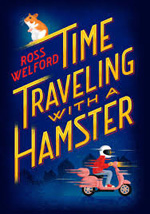 The novel begins with “My dad died twice. Once when he was 39 and again four years later, when he was 12.”On his 12th birthday, Al Chaudhury receives a letter from his dead father with a mission to go back to 1984 to prevent the go-cart accident that will lead to his death at 39 (when Al is 8). However, life for Al has changed. His mom is remarried, his stepfather tries to relate to him through sports (which Al hates) and gives him a hamster named for a sports hero for his birthday, and a stepsister doesn’t like him at all. Al must get to his former home, circumvent the current families living there, and locate a time machine hidden in a bunker. Concerned about him, Grandpa Byron teaches Al the Indian Memory Palace method to keep him rooted to present times. As Al travels to the past several times to carry out his father’s instructions, he uses his hamster to help keep track of when he is and the Memory Palace to keep track of what he is doing. If he can’t prevent his father’s childhood accident, or if he runs into his (younger) grandfather in the past, will Al even exist? This complicated time-travel story ends with a quick twist that will surprise readers.
The novel begins with “My dad died twice. Once when he was 39 and again four years later, when he was 12.”On his 12th birthday, Al Chaudhury receives a letter from his dead father with a mission to go back to 1984 to prevent the go-cart accident that will lead to his death at 39 (when Al is 8). However, life for Al has changed. His mom is remarried, his stepfather tries to relate to him through sports (which Al hates) and gives him a hamster named for a sports hero for his birthday, and a stepsister doesn’t like him at all. Al must get to his former home, circumvent the current families living there, and locate a time machine hidden in a bunker. Concerned about him, Grandpa Byron teaches Al the Indian Memory Palace method to keep him rooted to present times. As Al travels to the past several times to carry out his father’s instructions, he uses his hamster to help keep track of when he is and the Memory Palace to keep track of what he is doing. If he can’t prevent his father’s childhood accident, or if he runs into his (younger) grandfather in the past, will Al even exist? This complicated time-travel story ends with a quick twist that will surprise readers.
—NB
Ages 12–14
League of Archers (League of Archers #1). Eva Howard. 2016. Aladdin/Simon & Schuster.
 Twelve-year-old Ellie Dray’s mother sent her to the local nunnery and then was hanged. Orphaned Ellie and her friends, members of the League of Archers (a kind of Robin Hood fan club), meet up to hunt in secret. Imagine her horror when a stranger she meets one night in the woods is shot by a poisoned arrow and dies shortly after she drags him back to the convent—and he turns out to be Robin Hood. Imagine her surprise when her beloved abbess (who turns out to be Maid Marian) is arrested and sentenced to death by the nefarious Baron. Imagine her shock when, as the scapegoat, she is charged with the murder, and the villagers turn against her. Ellie ends up on the run, with the League helping her to free Maid Marian and find the murderer of Robin Hood. As the League of Archers learns that some of the actions of their hero and his Merry Men had serious repercussions that ended in his death, they vow to fight the Baron’s injustices and care for the villagers, just like Robin Hood did.
Twelve-year-old Ellie Dray’s mother sent her to the local nunnery and then was hanged. Orphaned Ellie and her friends, members of the League of Archers (a kind of Robin Hood fan club), meet up to hunt in secret. Imagine her horror when a stranger she meets one night in the woods is shot by a poisoned arrow and dies shortly after she drags him back to the convent—and he turns out to be Robin Hood. Imagine her surprise when her beloved abbess (who turns out to be Maid Marian) is arrested and sentenced to death by the nefarious Baron. Imagine her shock when, as the scapegoat, she is charged with the murder, and the villagers turn against her. Ellie ends up on the run, with the League helping her to free Maid Marian and find the murderer of Robin Hood. As the League of Archers learns that some of the actions of their hero and his Merry Men had serious repercussions that ended in his death, they vow to fight the Baron’s injustices and care for the villagers, just like Robin Hood did.
—NB
Merrow. Ananda Braxton-Smith. 2016. Candlewick.
 Twelve-year-old Neen, an orphan who lives on Carrick Island in the Irish Sea, seeks to learn who she really is. She knows that people consider her different because she suffers from a scaly-skin disease, and they whisper behind her back that her mother, who mysteriously disappeared after Neen’s father’s death, was a merrow, or mermaid, who returned to her people under the sea. If that is true, is Neen a merrow, too? Her stern Auntie Ushag, with whom she lives, never speaks of the past, and Neen suspects she knows more than she is telling her. Neen gathers every clue she can, including revelatory information from Skully Slevin, the blind fiddler, and when she explores a local cave, she is more confused than enlightened. After an earthquake cleaves the cliffs and exposes unexplored territory, the answers it brings Neen aren’t the ones she expected. The beautifully written prose, sometimes with a raw edge, in this historical fantasy will resonate with readers who are also trying to discover their own identities in this confusing world.
Twelve-year-old Neen, an orphan who lives on Carrick Island in the Irish Sea, seeks to learn who she really is. She knows that people consider her different because she suffers from a scaly-skin disease, and they whisper behind her back that her mother, who mysteriously disappeared after Neen’s father’s death, was a merrow, or mermaid, who returned to her people under the sea. If that is true, is Neen a merrow, too? Her stern Auntie Ushag, with whom she lives, never speaks of the past, and Neen suspects she knows more than she is telling her. Neen gathers every clue she can, including revelatory information from Skully Slevin, the blind fiddler, and when she explores a local cave, she is more confused than enlightened. After an earthquake cleaves the cliffs and exposes unexplored territory, the answers it brings Neen aren’t the ones she expected. The beautifully written prose, sometimes with a raw edge, in this historical fantasy will resonate with readers who are also trying to discover their own identities in this confusing world.
—NB
Ages 15+
The Door That Led to Where. Sally Gardner. 2016. Delacorte/Random House.
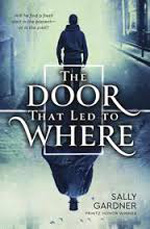 Almost-17-year-old Londoner AJ Flynn failed major exams so he can’t qualify for college, but he has been offered a job as a junior clerk at a law firm where others know more about him, his dead father, and his mother than he does. After overhearing a conversation between two men (one of whom is found dead the next morning), finding a mysterious key with his birthdate on it, and learning more about his family history from an eccentric professor, AJ’s life makes a 180-degree turn. When he opens a door with the key, he steps into 1830 London, discovers the missing son of a neighbor, and unexpectedly meets the love of his life, Esme. On subsequent trips to the past, he takes along two troubled childhood friends who have fallen on tough times. In a dangerous turn of events, they help him solve mysteries involving murder and smuggling to clear AJ’s family’s name before deciding to make the 1830s their home. Free to return to the law firm, AJ must choose the century he wants to live in, with, or without, Esme. This time-travel mystery will intrigue thoughtful readers. What happens in 1800s doesn’t always stay in the 1800s!
Almost-17-year-old Londoner AJ Flynn failed major exams so he can’t qualify for college, but he has been offered a job as a junior clerk at a law firm where others know more about him, his dead father, and his mother than he does. After overhearing a conversation between two men (one of whom is found dead the next morning), finding a mysterious key with his birthdate on it, and learning more about his family history from an eccentric professor, AJ’s life makes a 180-degree turn. When he opens a door with the key, he steps into 1830 London, discovers the missing son of a neighbor, and unexpectedly meets the love of his life, Esme. On subsequent trips to the past, he takes along two troubled childhood friends who have fallen on tough times. In a dangerous turn of events, they help him solve mysteries involving murder and smuggling to clear AJ’s family’s name before deciding to make the 1830s their home. Free to return to the law firm, AJ must choose the century he wants to live in, with, or without, Esme. This time-travel mystery will intrigue thoughtful readers. What happens in 1800s doesn’t always stay in the 1800s!
—NB
Heartless. Marissa Meyer. 2016. Feiwel and Friends.
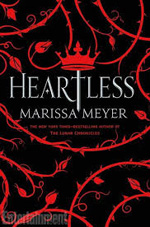 In this prequel to Lewis Carroll’s Alice’s Adventures in Wonderland, Marissa Meyer tells the story of Lady Catherine (Cath) Pinkerton, whose love of baking and dreams of opening her own shop with her maid are at odds with the intent of her mother, the Marchioness of Rock Turtle Cove, to have her become the Queen of Wonderland. In Meyer’s fantasy, many of the characters from Carroll’s classic tale, including the Cheshire cat, the Mad Hatter, the March Hare, and the Jabberwock, have roles to play as Cath’s abhorrence of the bumbling King of Hearts’ courtship intensifies after she falls for the king’s new court jester, Jest. The subsequent adventures, or rather misadventures, of Cath in Wonderland reveal how she becomes the tyrannical and heartless “off with their heads” Queen of Hearts.
In this prequel to Lewis Carroll’s Alice’s Adventures in Wonderland, Marissa Meyer tells the story of Lady Catherine (Cath) Pinkerton, whose love of baking and dreams of opening her own shop with her maid are at odds with the intent of her mother, the Marchioness of Rock Turtle Cove, to have her become the Queen of Wonderland. In Meyer’s fantasy, many of the characters from Carroll’s classic tale, including the Cheshire cat, the Mad Hatter, the March Hare, and the Jabberwock, have roles to play as Cath’s abhorrence of the bumbling King of Hearts’ courtship intensifies after she falls for the king’s new court jester, Jest. The subsequent adventures, or rather misadventures, of Cath in Wonderland reveal how she becomes the tyrannical and heartless “off with their heads” Queen of Hearts.
—CA
Nancy Brashear is Professor Emeritus of English from Azusa Pacific University, in Azusa, CA. Carolyn Angus is former director of the George G. Stone Center for Children's Books, Claremont Graduate University, in Claremont, CA.
These reviews are submitted by members of the International Literacy Association's Children's Literature and Reading Special Interest Group (CL/R SIG) and are published weekly on Literacy Daily.